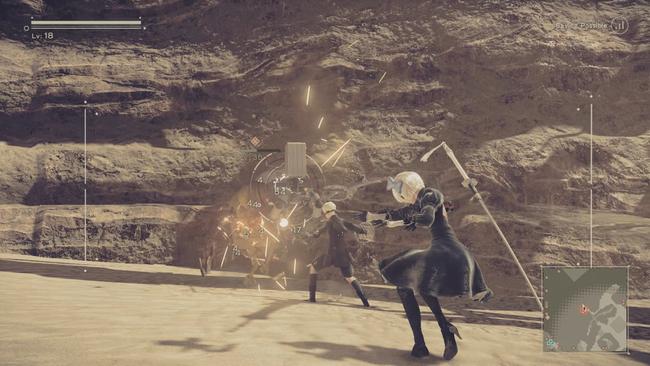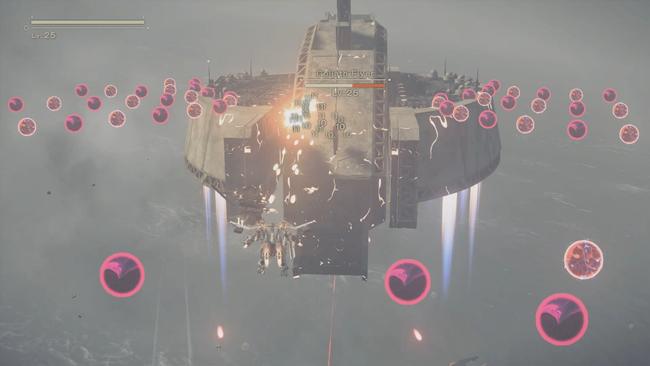
Nier: Automata Review
Nier: Automata's announcement was a shocker. A sequel to Nier was unexpected to begin with, but to have Platinum Games on board to handle much of development was doubly so. I thought it was an oddly fitting match; I was never strongly fond of Nier director Yoko Taro’s gameplay systems in the Drakengard series or the original Nier, but the tales in his works are still among the strangest and the strongest in the business.
As such, the Platinum announcement left me very curious to see how the two styles would mix. Platinum Games are no slouch when it comes to combat, but they've had their fair share of misfires too. How they'd mesh with Yoko's weird and wonderful direction was never guaranteed to be good. But it is.
Nier: Automata is one of the most stunning and thought-provoking experiences I’ve ever had in gaming. Automata is an odd mix of ideas densely packaged together. It stays true to Taro’s unconventional presentation in storytelling without having a dull combat system to drag it down. Battles are smooth, intense, and at times, downright entertainingly weird.
Knowledge of the first Nier is not mandatory to enjoy Automata, though those with the knowledge will appreciate its callbacks to that and all of Taro's previous projects. It's an unrelenting expansion of Yoko's gaming universe, but an equally appropriate introduction.

The game's base premise is a pretty bleak one for the human race. They’ve been forced to flee to the moon because of a devastating alien invasion on Earth. The invaders used machine lifeforms to take over. In response, humans developed the YoRHa android unit and deployed them from several of Earth’s orbiting bases to take back their home planet. You take control of one of these units in this mechanical war - YoRHa No. 2 Model B, or 2B.
After a mission gone haywire, 2B and her new partner 9S are tasked with assisting a resistance camp battling the machine threat. Though Automata is technically an open world game, it’s similar to the original Nier in structure - wide open zones that are now seamlessly linked together without a loading screen. The abandoned city ruins you land in acts as a central hub connecting all of the various places you’ll be visiting throughout the story.
Travel is snappy and quick. Thanks to being an android, 2B sprints rapidly without tiring herself. Dashing, double jumping, and gliding on her floating pod assistant makes traveling these zones quite fast. There are also vending machines scattered throughout the world that act as quick save spots and eventually fast travel points.
One of the first things that struck me in Nier: Automata was how washed out its visuals are. Everything seems abnormally desaturated; vibrant spots are few and far in-between. It bothered me at first, but I realized that this direction actually benefits the game’s atmosphere. The suppressed color palette conveys the dreary state of the world. There are tiny deliberate moments in which the color shines through - instances of hope among dire circumstances. Automata is filled with small moments that are endearingly charming like this.
My favorite parts of Automata lie in small events scattered throughout its abundant sidequests. These flesh out the world and its history in creative ways. Each provdes small nods that slowly build upon the underlying themes that Automata tackles.
Though the grunt-work to complete these quests is often quite pedestrian, the narrative implications of each began to astound me once I realised why I was doing them - far beyond the generic reason of an NPC being in trouble. It has to be said that the quests do get repetitive at times, but they certainly served a greater purpose that made me thankful that I didn’t skip out on them. Rewards from sidequests, numerous chests, and drops from enemies all feed into the game’s somewhat extensive RPG subsystems.
2B has a lot of options to consider before swooping into combat. She has two interchangeable sets of weapons and can switch between these sets freely during battles allowing players to mix and match weapon movesets. Whether you find them or buy them from shops, all of them can be upgraded using materials. Upgrades not only make them more powerful, but also add properties like increasing attack speed or offering you a discount from shops when equipped.
Her little pod can also be leveled and outfitted with programs to assist her in combat too. From a spinning blade, firing off laser shots, or even wiring yourself toward an enemy, the pod adds an extra layer of assistance to bolster 2B’s offensive capabilities. Other hidden pods provide their own share of surprises as well.
Plug-in chips you can equip grant passive abilities. These functions vary too allowing for some decent RPG customisation: you can increase various stats, heal yourself over time or give your weapon swings rippling shockwaves, for instance. Each skill chip is assigned a cost; 2B’s slots for them are fairly limited early on, so I decided to invest my earnings in freeing up more space for them. All these chips can be upgraded, but doing so will raise their cost. It’s a neat little system that requires players to balance their priorities on what they value.

Your plugins run the risk of being lost upon death. If 2B dies, players are transported back to the last quicksave point with their installed set of plug-in chips gone. You must retrieve your corpse to retrieve them but if you die before doing so, you can say goodbye to those precious plugins. Sometimes you may see the corpse of someone else if you’re connected online; you can either retrieve them to temporarily get some of their plug-in bonuses or repair them to temporarily have an AI-controlled buddy fight by your side.
The battle system is similar to what you’d see in other higher-caliber titles from Platinum Games. Instant dodges let you retaliate with a strong counterattack. Special plug-in chips even allow you to slow down time or detonate enemy projectiles. Perhaps the most striking thing about Automata’s fights are its intricate animations. It’s almost as if 2B is dancing around the battlefield; her attack strings flow beautifully from one attack to the next.
Combat isn’t limited to just a typical hack-and-slash perspective. Much like the original Nier, Automata mixes up not only your camera’s perspective, but also practically switches genres too. For instance, there are times in which 2B uses a flight unit and it changes to a shoot ‘em up with a flow resembling Astebreed’s take on it. I found these segments enjoyable and they lasted long enough to not overstay their welcome.
Nier is still praised to this day for its fantastic score and Nier: Automata is no different; a phenomenal soundtrack accompanies it. Emi Evans and Nami Nakagawa make their return to provide their outstanding vocals and are joined by newcomer J'Nique Nicole. We don't often name artists in our reviews, but it's worth doing here. Together, the trio provide chillingly gorgeous melodies that give Automata's post-apocalyptic world an extra layer of depth.
All of this is the work of Keiichi Okabe and his Monaca studio - also returning from Nier to pen the score. The music and sound design in Automata is truly one of its most important aspects. Its musical design serves to hold together all of its different elements and, in many ways, is the glue that keeps the experience cohesive. I would place it at the same caliber as the first Nier and those who have played that game will know that’s a tremendous achievement.
Even the localization sings, with both the Japanese and English voice performances easy to appreciate. 2B and 9S’s relationships with each other and the inhabitants of the world around them are elegantly conveyed. Pascal and some of the machines you encounter have some clever audio mixing to vary up their mechanical tones and tempo. I was delighted to hear the voice acting pull off some of the crazy twists in the later parts of the game.
Every aspect of Nier: Automata up to this point ranges from decent to very good, so where does its X-factor lie? What propelled it to being one of my favorite gaming experiences in a long time?

The answer is simple: its presentation. Or rather, the deception in its presentation.
Without getting into spoilers, Automata is longer than it initially lets on. One “playthrough” of it took me roughly 15 hours, but reaching that single ending doesn’t mean the story is finished. In fact, I’d say that reaching that first ending is only about 30% of the overall plot at best. What we’d traditionally call New Game+ is more substantial than you might think thanks to how it provides vital contextual information through an alternative lens - so to speak.
Completing that “New Game+” opens up an entirely new side to Automata that’s too filled with spoilers to really delve into, but this final piece of the game is what sealed the deal on my love for it.
Case in point - don’t assume the story is finished because you saw an ending. Completing the entire main story took me about 35 hours, but Automata is packed with a lot of other bonuses. There are myriad alternative endings; think “bad endings” in visual novels that are just small what-if scenarios on “incorrect” decisions you may have made or done. The twists and turns the game takes are what make it truly special, especially when combined with such a tight and engaging combat experience.
Automata’s biggest downfall is its technical performance. I played it on a base PlayStation 4 model and while it certainly can hit 60fps, it struggles to maintain it often. There are certainly hiccups and hitches in its framerate, but it never got in my way during combat.
This issue is most noticeable when entering a new zone; I was definitely met with some instability transitioning from the ruined city to the forest zone. In fact, I think the forest zone is where the game has the most problems in performance. These sorts of problems are a pain, though there is the PS4 Pro and of course, the upcoming PC version that will hopefully serve to remedy that to a decent degree.
Nier: Automata is not a perfect game by any means. There are flaws in its repetitive sidequest design and issues with its framerate on a standard PS4. Despite that, there’s an overwhelming amount of things that it absolutely nails. It's this that makes it a must-play - perfection isn't required.
The combat and the RPG systems are fun and interesting, but what will likely stick with you from Automata is its thematic strength. You might be pulling off bad-ass combos in slick, speedy combat, but the game can also give you pause to muse about the existential philosophies it posits and questions - that's a special thing indeed. Backed by an excellent battle system thanks to Platinum, Automata is Yoko Taro’s magnum opus - and it's one of the best games I’ve ever played.
